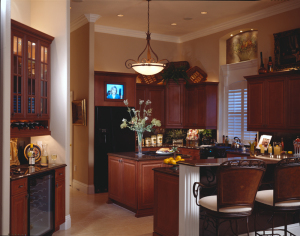Home Lighting
By Craig DiLouie, LC

Downlights provide ambient and shelf lighting, directional luminaires accent artwork, and undercabinet lighting illuminates the countertop. Lighting design by Gregg Mackell, 186 Lighting Design Group. Photo by Cooper Lighting.
Color, texture, pattern: Interior designers layer these elements to create interesting, dynamic rooms. The layered approach is also used in lighting design. However, with lighting, layering involves combining ambient, accent and task lighting to create a balanced, visually comfortable space.
Ambient Lighting
Ambient (or general) lighting uniformly lights the space, typically avoiding dark corners while also putting some light on walls. Typically provided by ceiling-mounted luminaires (light fixtures), it provides light mainly for orientation and general vision. Examples of ambient lighting include downlights, pendants, cove lighting and wall washing.
Because ambient lighting is typically diffuse and uniform, it can be bland. Accent lighting can be used to highlight features in the space such as artwork, floral arrangements and interesting architecture. The goal is to draw attention through contrasts in brightness. Instances of accent lighting include directional luminaires, track lighting, aimable downlights and wall washing and grazing. Visual interest can also be stimulated by incorporating sparkle elements (such as a starry sky effect using points of light), decorative luminaires, color and silhouetting.
Task Lighting

A kitchen is dimmed to a preset lighting scene for entertaining. Photo by Philips Lighting.
Task lighting is then used to provide supplemental illumination for specific activities requiring more light, such as reading, sewing, personal grooming and preparing meals. It may be part of the general lighting system or additional localized lighting such as portable desktop, table and floor luminaires, or reading lights. As these luminaires are typically visible, their style and finish should match the décor of the space.
Once the layers are defined and equipment chosen that will distribute light in the desired direction, intensity and pattern, each should be assigned to a control device that provides switching and also possibly dimming. By making each layer separately dimmable, you can establish a wide variety of visual scenes, moods and functionality. If preset scene controls are used, these scenes can be programmed and recalled via single pushbutton operation.
What You Need To Know About Layering With Light:
- Layering light is the key to lighting design
- Layering light in a space provides functionality and visual interest
- Primary layers include ambient, accent, task
- Separately controlling layers can provide high level of flexibility